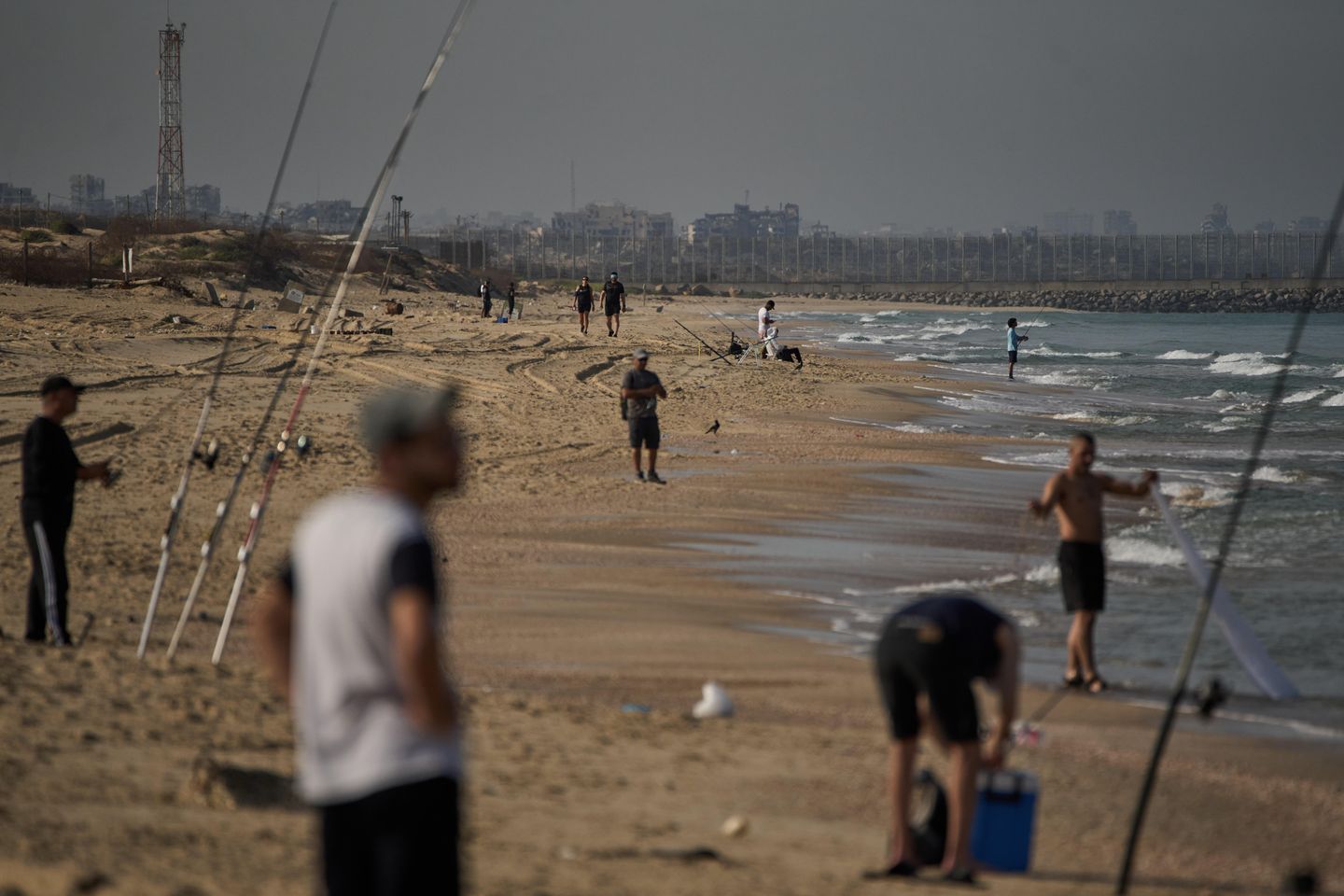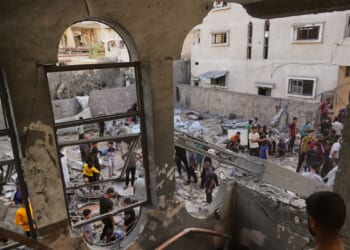
DEIR AL-BALAH, Gaza Strip — Israel received the remains of another hostage from Gaza on Friday, the prime minister’s office said, a handover from Hamas as the militant group worked to shore up a ceasefire by using bulldozers in a search for bodies under the rubble in the war-scarred enclave.
The Israeli military and security forces received the coffin from the International Committee of the Red Cross inside the Gaza Strip, and it was to be sent to the Ministry of Health’s National Center for Forensic Medicine in Israel.
Israeli authorities said the family of the deceased would be notified first after a formal identification process.
The handover came after Hamas’ military wing, known as the Qassam Brigades, said the remains were that of an “occupation prisoner,” suggesting that they belonged to an Israeli rather than one of the hostages of several other nationalities also taken in Gaza.
The handover of hostages remains, called for under the ceasefire agreement, has been among the key sticking points – along with aid deliveries, the opening of border crossings into Gaza and hopes for reconstruction – in a process backed by much of the international community to help end two years of devastating war in Gaza.
Hamas has said it is committed to the terms of the ceasefire deal, including the handover of bodies. This week, Hamas has handed over to Israel the remains of nine hostages, along with a 10th body that Israel said wasn’t that of a hostage.
The effort to find bodies followed a warning from U.S. President Donald Trump that he would green-light Israel to resume the war if Hamas doesn’t live up to its end of the deal and return all hostages’ bodies, totaling 28.
The Israeli military and Shin Bet security service, which received the remains, insisted that “Hamas is required to uphold the agreement and take the necessary steps to return all the deceased hostages.”
Hamas has said some hostages’ remains were in tunnels or buildings that were destroyed by Israel, and insisted heavy machinery is required to dig through rubble to retrieve them. The group blamed Israel for the delay, saying it had not allowed any new bulldozers into the Gaza Strip.
Most heavy equipment in Gaza was destroyed during the war triggered by the Oct. 7, 2023 attacks in Israel, leaving only a limited amount as Palestinians try to clear massive amounts of rubble across the territory.
On Friday, two bulldozers plowed up pits in the earth as Hamas searched for hostages’ remains in Hamad City, a complex of apartment towers in the city of Khan Younis. Israeli forces repeatedly bombarded the towers during the war, toppling some, and troops conducted a weeklong raid there in March 2024, fighting militants.
While much focus has been on the handover of hostages’ remains, Hamas has urged mediators to increase the flow of aid into Gaza, expedite the opening of the Rafah border crossing with Egypt and start reconstruction.
It also said work should “start immediately” to set up a committee of Palestinian independents who will run Gaza and called for Israeli troops to continue pulling back from agreed-upon areas.
The ceasefire plan introduced by Trump had called for all hostages – living and dead – to be handed over by a deadline that expired Monday. But under the deal, if that didn’t happen, Hamas was to share information about deceased hostages and try to hand them over as soon as possible.
Israeli Prime Minister Benjamin Netanyahu has said that Israel “will not compromise” and demanded that Hamas fulfill the requirements laid out in the ceasefire deal about the return of hostages’ bodies.
Hamas has assured the U.S. through intermediaries that it’s working to return dead hostages. The retrieval of bodies is hampered by the scope of the devastation and the presence of dangerous, unexploded ordnance. The militant group has also told mediators that some bodies are in areas controlled by Israeli troops.
At a news conference with his German counterpart in Ankara, Turkish Foreign Minister Hakan Fidan expressed concerns that Israel might use Hamas’ “lack of equipment” to recover bodies as a pretext to resume hostilities.
Hamas released all 20 living Israeli hostages on Monday. In exchange, Israel freed around 2,000 Palestinian prisoners and detainees.
In Israel, the Hostage and Missing Families Forum – which groups many families of hostages – said they will continue holding weekly rallies until all remains are returned.
Israel has also returned to Gaza the bodies of 90 Palestinians for burial. Israel is expected to turn over more bodies, though officials have not said how many are in its custody or how many will be returned.
A Palestinian forensics team examining the remains said some of the bodies showed signs of mistreatment.
Israel’s campaign in Gaza has killed nearly 68,000 Palestinians, according to the Health Ministry, which is part of the Hamas-run government in the territory. Thousands more people are missing, according to the Red Cross.
France said it’s working with Britain and the U.S. to propose a U.N. resolution in coming days that would provide a framework for an international force for Gaza.
French Foreign Ministry spokesperson Pascal Confavreux said Thursday that Arab countries want a U.N. mandate for the force.
Arab countries are expected to be among those contributing troops to the force, which will oversee Egyptian-trained Palestinian police.
Confavreux said details on funding, equipment and which countries will participate still need to be worked out.
Meanwhile, the flow of aid remains constrained because of continued closures of crossings and restrictions on aid groups.
The United Nations dashboard tracking movement of U.N.-coordinated aid trucks into Gaza on Friday showed 339 trucks have been offloaded for distribution since the ceasefire began a week ago. Under the agreement, some 600 humanitarian aid trucks would be allowed to enter Gaza daily.
COGAT, the Israeli defense body overseeing aid in Gaza, reported 950 trucks – including commercial trucks and bilateral deliveries – crossing on Thursday and 716 on Wednesday, according to the U.N. office for the coordination of humanitarian aid.
Tom Fletcher, who heads that office, said in a social media post that U.N. humanitarian teams are executing a 60-day plan to massively scale up aid. Still, he warned that the “challenges ahead are immense,” and urged the opening of more crossings to allow more aid and workers into Gaza.
Fletcher entered the Israeli side of the Kerem Shalom crossing from Egypt and then drove to Deir al-Balah in central Gaza, where he visited the U.N. World Food Program’s Castle Bakery, U.N. spokesperson Stéphane Dujarric said.
“The ceasefire has meant that the bakery can access fuel and flour, allowing it to produce up to 300,000 loaves of pita bread per day,” Dujarric said.
Since last Saturday, WFP has sent more than 280 trucks, weighing some 3,000 metric tons, into Gaza to support bakeries, nutrition programs and general food distributions, the food agency said.
Nahed Sheheiber, the head of Gaza’s private truckers’ union, which organizes pickups of aid after Israeli inspection, says improved security in Gaza has helped prevent looting or gangs intercepting aid convoys – even if there has been no significant increase of supplies arriving since the ceasefire. He said only 70 trucks went in Thursday.
Gaza’s more than 2 million people are hoping the ceasefire will bring relief from the humanitarian disaster caused by Israel’s campaign. Throughout the war, Israel restricted aid entry to Gaza, sometimes letting in only a trickle, and it completely barred food from entering for two months earlier this year to pressure Hamas to free hostages.
Famine was declared in Gaza City, and the U.N. says it has verified more than 400 people who died of malnutrition-related causes, including more than 100 children.
Israel says it let in enough food, accusing Hamas of stealing much of it. The U.N. and other aid agencies deny the claim.
___
Associated Press writers Edith M. Lederer at the United Nations; Suzan Fraser in Ankara, Turkey; and Angela Charlton in Paris contributed.











